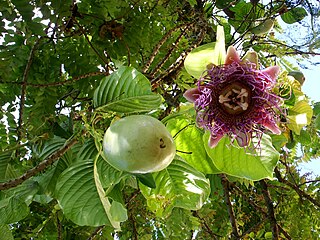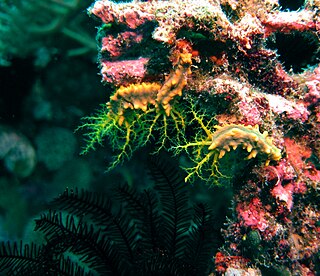
Passiflora quadrangularis, the giant granadilla, barbadine (Trinidad), grenadine (Haiti), giant tumbo or badea, is a species of plant in the family Passifloraceae. It produces the largest fruit of any species within the genus Passiflora. It is a perennial climber native to the Neotropics.

Cissus is a genus of approximately 350 species of lianas in the grape family (Vitaceae). They have a cosmopolitan distribution, though the majority are to be found in the tropics.
Alona is a genus of cladocerans in the family Chydoridae. It is one of the largest genera of Cladocera, and is widely believed to be an artificial group which is in need of systematic revision; the type species is Alona quadrangularis. Around 240 names at the species level have been described in Alona; it is unclear how many of these are valid, or how they are related.
Beauprea congesta is a species of plant in the family Proteaceae. It is endemic to New Caledonia.
Beauprea crassifolia is a species of plant in the family Proteaceae. It is endemic to New Caledonia.

Erithalis is a genus of flowering plants in the family Rubiaceae. The genus is found from southern Florida to tropical America.
Helicia albiflora is a species of plant in the family Proteaceae. It is endemic to Papua New Guinea. It is threatened by habitat loss.
Helicia amplifolia is a species of plant in the family Proteaceae. It is endemic to Papua New Guinea. It is threatened by habitat loss.
Helicia calocoma is a species of plant in the family Proteaceae. It is endemic to Papua New Guinea. It is threatened by habitat loss.
Helicia insularis is a species of plant in the family Proteaceae. It is endemic to Papua New Guinea. It is threatened by habitat loss.
Leucadendron nobile is a species of plant in the family Proteaceae. It is endemic to South Africa.
Melicope quadrangularis, also called four angle melicope or four-angled pelea, is a species of plant in the family Rutaceae. It is endemic to the Hawaiian Islands, where it is known only from the island of Kauai. It is threatened by habitat loss.
Roupala sphenophyllum is a species of plant in the family Proteaceae. It is endemic to Peru.
Stenocarpus villosus is a species of plant in the family Proteaceae. It is endemic to New Caledonia. It is threatened by habitat loss.
Tarenna quadrangularis is a species of plant in the family Rubiaceae. It is endemic to Tanzania.

Cissus quadrangularis is a perennial plant of the grape family. It is commonly known as veldt grape, devil's backbone, adamant creeper, asthisamharaka or asthisamhara, hadjod and pirandai. The species is native to tropical Asia, Arabia and much of Africa.

Brasilodontidae is an extinct family of cynodonts closely related to mammals. In life, brasilodontids were small-bodied and probably insectivorous. Most brasilodontid remains are known from the Late Triassic of Brazil, having been found in the municipalities of Candelária and Faxinal do Soturno. The species Brasilodon quadrangularis, is known only from Paleorrota. Brasilodonts are also known from Argentina. An Indian species of cynodont called Panchetocynodon damodarensis has also been assigned to Brasilodontidae. It dates back to the Early Triassic, tremendously extending the temporal range of the family.

Colochirus quadrangularis, commonly known as the thorny sea cucumber, is a species of sea cucumber in the family Cucumariidae. It is found in shallow seas in tropical parts of the Indo-Pacific region.

Rhigospira is a genus of flowering plants in the family Apocynaceae, first described as a genus in 1878 by John Miers. The species, Rhigospira quadrangularis was first described as Ambelania quadrangularis by Johannes Müller Argoviensis in 1860 but was transferred to the genus, Rhigospira, in 1878 by John Miers. The genus contains only one known species, Rhigospira quadrangularis, native to northwestern South America.

Funiculina quadrangularis, commonly known as tall sea pen, is an uncommon cold water coral within the Family Funiculinidae. It is named tall sea pen because it looks like a quill sticking in the bottom of the sea. It forms habitat for several key crustacean species.








